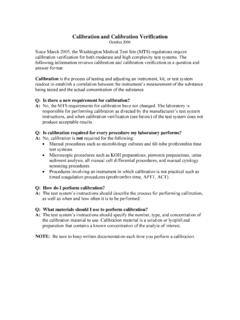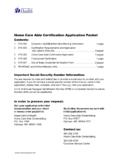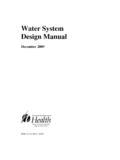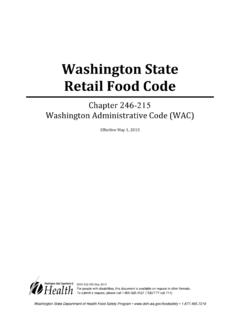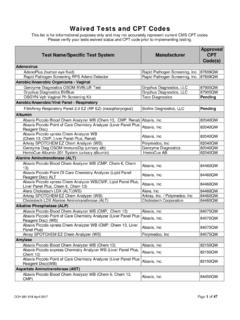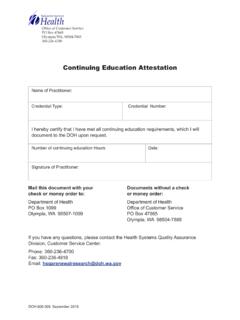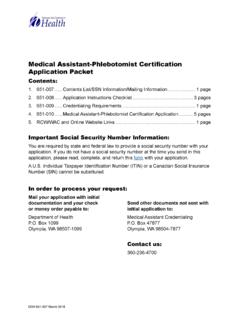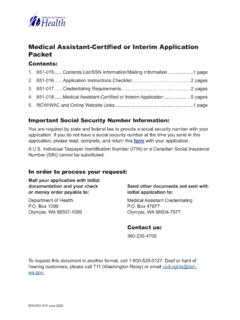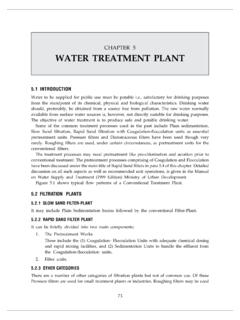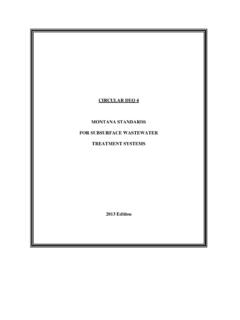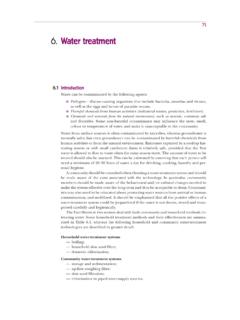Transcription of Standard Operating Procedures for Water Treatment Plants
1 Frequently Asked Questions Standard Operating Procedures for Water Treatment Plants 331-647 4/15/2020 Frequently Asked Questions 1. What is an SOP? A Standard Operating procedure or SOP is a set of step-by-step instructions describing how operators carry out routine tasks. An SOP often lists the materials and supplies needed and can include references to industry standards , equipment manuals and regulatory requirements. 2. Why are SOPs important? Written SOPs help ensure every operator at your facility follows consistent and correct Procedures , your utility follows industry best practices and your plant meets regulatory requirements. During this time of COVID-19, SOPs are as important as ever. When staff turnover occurs or outside operators assist during an emergency, SOPs help new operators come up to speed quickly and help ensure nothing important is missed. 3. We want to document our SOPs to make it easier for a new operator to learn about our plant. What should we consider during the process?
2 Develop SOPs for every critical activity. They should be written down, up-to-date, and easily available. Include process flow schematics showing critical valves and monitoring locations. Review equipment manuals and engineering reports to incorporate manufacturers and engineers recommendations. Make SOPs short and simple, while still covering what s important. This makes them easier to develop, review and update. Store SOPs in a visible and easily reached location and keep duplicate copies in a secure offsite location. During an emergency, when time is short, operators can write SOPs by hand using a template. Editing and formatting can always be performed after the emergency has passed. 4. What are critical activities? The Treatment processes installed at your plant and your Water quality goals determine the SOPs you need. Think about the consequences of failing to do a task correctly. Will Treatment be compromised or ineffective? Will chemical feed systems dose incorrectly?
3 Will monitoring devices generate incorrect results? Prioritize tasks where failure could place public health at risk, expose operators to an unsafe situation or incur a regulatory violation. The table below has suggested core SOPs for common disinfection and filtration processes. 3. Where can we find example SOPs? Refer to the operations and maintenance manual developed during plant construction. Consult with your design engineer. Ask other utilities that have similar Treatment processes if they are willing to share. Join professional organizations, especially those that specialize in your Treatment process. Refer to the references below. Contact your ODW Regional Office. 4. How can we test our SOPs? Have one person write the SOP and another person review it. Have an experienced operator observe a new employee performing the task while following the SOP. For a small system, have your main operator write the SOP and the backup operator review it. 5. How often should SOPs be updated?
4 Update an SOP every time plant staff discover and agree on a better way to perform that task. Review them at least once per year and after a plant upset or problem to incorporate lessons learned from the event. Write the most recent review date on the SOP. After each revision update the secure off-site back up copy. If you have any more questions, please call your ODW Regional Office. Eastern Region Northwest Region Southwest Region 509-329-2100 253-395-6750 360-236-3030 Core Standard Operating Procedures (SOPs) for Water Treatment Plants (For bold numbers, refer to footnotes below.) Treatment Process Technology Topics and Resource Links General All 2, 22 Process start-up/shut down 32 Operator rounds/daily routine checks 32 Chemical batch/feed solution makeup for each chemical used at the plant. Include safety Procedures . 4, 5, 6, 32 Chemical feed calibration-dry and liquid feed systems 6, 32 Chemical overfeed protection 31 Chemical dose determination-Instantaneous (from feed pump drawdown) and daily average dose (from daily chemical use) 3, 6,32 Chemical handling, procurement and deliveries for each chemical used at the plant.
5 Include safety Procedures . 4, 5, 6 Compliance monitoring and reporting. 15, 24 Disinfection performance monitoring. For surface Water Treatment : calculating daily inactivation ratio. 15, 24 Measuring critical Water quality parameters. For surface Water Treatment : turbidity, temperature, pH and chlorine residual 15, 21 Water quality instrumentation maintenance, calibration and verification. For surface Water Treatment : turbidity, pH and chlorine residual 15 Flow meter and level sensor calibration 15 Identify and list all alarm setpoints and testing Procedures . 15 Security and physical access control. Others as applicable: source/intake maintenance 32, changing Water source, seasonal startup 23, pneumatic system maintenance, Disinfection Chlorine Operations, general 28, 32 Core Standard Operating Procedures (SOPs) for Water Treatment Plants (For bold numbers, refer to footnotes below.) Treatment Process Technology Topics and Resource Links On-site generation 16 Disinfection Ozone Operations, general 1, 32 Ozone residual measurement 21 Ozone chemical safety and ozone destruct system Ozone generator, air drying equipment maintenance and operation UV Operations, general 27, 30 Verifying and calibrating sensors, meters and alarms 15 Cleaning and replacing lamps Dose verification Lamp breakage response plan Filtration Bag/Cartridge Operations, general (including changing pre-filters) 8 Changing pathogen removal filters Verifying pressure gages Measuring flow and pressure differential Diatomaceous Earth (DE) or Pre-Coat Operations, general (including pre-coat) 9,19 Core Standard Operating Procedures (SOPs) for Water Treatment Plants (For bold numbers, refer to footnotes below.)
6 Treatment Process Technology Topics and Resource Links Vacuum system maintenance Membrane, Ultra-, Micro- Operations, general 13 Pressure decay test Clean in place Chemical neutralization and disposal Filtration Pressure sensor calibration Module shut down Fiber break identification and repair Rapid and High-rate Granular Media Operations, general 18 Coagulation control (determining optimal chemical doses) 26 Jar testing, streaming current, zeta potential filter backwash, backwash recycle and waste handling 7,11 filter maintenance 10 Addressing a plant upset slow sand Operations, general (including seasonal changes) 17, 20, 29 filter cleaning/scraping (or harrowing if used at the plant) filter ripening (and initial commissioning) Core Standard Operating Procedures (SOPs) for Water Treatment Plants (For bold numbers, refer to footnotes below.) Treatment Process Technology Topics and Resource Links Checking or changing filter rate Roughing filter maintenance 25 Resanding sand washing (to reuse sand removed through scraping process, to avoid having to find a supplier) Resource Links 1.
7 Alternative Disinfectants and Oxidants Guidance Manual, USEPA, 1999. 2. AWWA G100-17 Water Treatment Plant Operation and Management, AWWA, 2017. 3. Calculating Chemical Dose, Liquid Polymer Coagulant (331-592), Washington Department of Health, April 2017. 4. Caustic Soda Handbook, Occidental Chemical Corporation, 2018. 5. Caustic Soda Solution Handbook, Dow Chemical, 2017. 6. Chemical Feed Guide for Water Treatment Plant Operators, AWWA, 2009. 7. Drinking Water filter Backwashing, National Environmental Services Center, 2004. 8. Drinking Water Operator Certification Training Module 18: Bag Filtration and Cartridge Filtration, Pennsylvania Department of Environmental Protection, 9. Drinking Water Operator Certification Training Module 16: Diatomaceous Earth Filtration, Pennsylvania Department of Environmental Protection, 10. filter Assessment Manual, South Carolina Department of Health and Environmental Control, Third Edition, December 2003. 11. filter Backwash: Tips for Surface Water Sources with Rapid Rate Filtration (331-624), Washington Department of Health, 12.
8 Freezing Points of Sodium Hydroxide Solutions, Hawkins, Inc. 13. Membrane Filtration Guidance Manual, USEPA, 2005. 14. Microfiltration and Ultrafiltration Membranes for Drinking Water , Second Edition, AWWA Manual of Practice M53. 15. Monitoring Surface Water Treatment Processes (331-620), Washington Department of Health, December, 2019. 16. On-site Generation of Hypochlorite, AWWA Manual of Practice M65. 17. Operating and Maintaining slow sand Filters, Technical Note no. RWS. , Water for the World, 1962. 18. Optimizing Water Treatment Plant Performance with the Composite Correction Program, USEPA, 1998. 19. Pressure Filtration with Diatomaceous Earth (DE): A Simple Guide for Efficient filter Operation, Celatom filter Aids, 2014. 20. slow sand Filtration: Recommended Operations and Optimization Goals (331-601), Washington Department of Health, June, 2018. 21. Standard Methods for the Examination of Water and Wastewater, 23rd edition, Rice, Baird, Eaton, editors, 2017.
9 22. Standard Operating Procedures (SOP) Cooperative Library. 23. Start-up and Shut-down Assistance for Seasonal Noncommunity Water Systems (331-314-1), Washington Department of Health, 2011. 24. State Board of Health Drinking Water Regulations, Chapter 246-290 WAC, 2019. 25. Surface Water Treatment by Roughing Filters-A Design, Construction and Operation Manual, SANDEC-SKAT, 1996. 26. Treatment Optimization Program poster, Washington Department of Health. 27. Ultraviolet Disinfection Guidance Manual, USEPA, 2006. 28. Water Chlorination & Chloramination Practices and Principles, Second Edition, AWWA Manual of Practice M20. 29. Water System Design Manual: Appendix H slow sand Filtration (331-123), Washington Department of Health, 2019. 30. Water System Design Manual: Appendix I Ultraviolet Disinfection (331-123), Washington Department of Health, 2019. 31. Water System Design Manual: Section Treatment Chemicals (331-123), Washington Department of Health, 2019. 32. Water Treatment Plant Operation, Volume 1, 7th Edition, Sacramento State Water Programs, 2017.
10 33. Water Treatment Plant Operation, Volume 2, 6th Edition, Sacramento State Water Programs, 2015. To request this document in another format, call 1-800-525-0127. Deaf or hard of hearing customers, please call 711 (Washington Relay) or email
